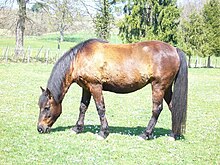Landais pony
Traditionally, two distinct types of pony or small horse lived in a feral or semi-feral state in the Landes de Gascogne region of south-western France: the Lédon or Poney des Pins in the sandy coastal areas of the Gironde and the Haute-Lande [fr]; and the Barthais in the Barthes de l'Adour [fr], the marshy meadowlands of the valley of the Adour river.
[4][5] The plantation of the Landes forest and associated swamp drainage operations in the nineteenth century reduced the natural range of these horses.
[4][6]: 186 The advent of motorised transport led to a decline in the number of animals, both because their usefulness was reduced and because some were the cause of road accidents; during the Second World War, some fell victim to land-mines laid by German forces to prevent coastal landings.
[9]: 5 Some Landais ponies live in a semi-feral state with other livestock and wildlife on the banks of the Adour and Luy rivers in the area of Dax in the Landes,[4] but the largest number is found in the arrondissement of Pau, in the département of Pyrénées-Atlantiques.Others are reared elsewhere in Nouvelle-Aquitaine, and in the Auvergne-Rhône-Alpes, Centre-Val de Loire, Occitanie and Pays de la Loire regions.
[2]: 8 The Landais is used as a riding horse – often by children – for hacking out and trekking, and in competition sports such as jumping, eventing and dressage.

